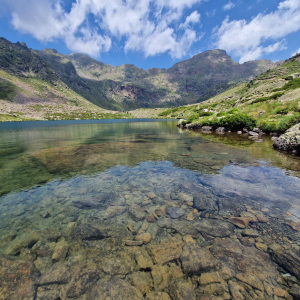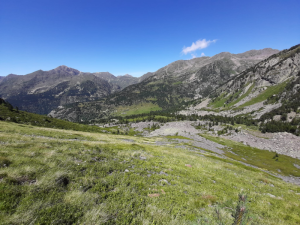
Since earning his M.S. degree a year ago from the UF/IFAS Department of Soil, Water, and Ecosystem Sciences, Anthony Halcyon has been eyeing ways to grow as a scientist and expand his scope of understanding in this field. In doing so, Anthony came across a group called Earthwatch. The global environmental organization connects adventurous travelers with science researchers. The result is a chance to be a part of fieldwork that has sound environmental practices and addresses ecological challenges. Andorra was the setting for one of these opportunities. This is Anthony’s journey in soil and water sciences at a high elevation.
By Anthony Halcyon
Andorra is a landlocked principality within the Pyrenees mountains between France and Spain. Famous as a tourist friendly country with stunning alpine scenery, Andorra has beautiful, rugged mountains, valleys, and glacial lakes. The country is outstanding for outdoor enthusiasts and offers an excellent range of recreation. It is known for skiing, hiking, and birdwatching. Andorra also has a unique blend of cultures with Catalan and French influences.
The expedition itself was immensely well rounded. While my primary interest lay in the Soil and Water Sciences portions—there was also small mammal indexing, measuring of trees at varying elevations with analog as well as digital dendrometers, and bird banding. That said, I could certainly see an expedition such as this being just as appealing to students taking wildlife science and conservation course work as well. My goal was to collect sediment and diatom samples from each of the three lakes that make up Estanys de Tristaina: Upper Tristaina, Middle Tristaina, and Lower Tristaina, as well as from Estany de l’Estanyo. Diatoms are under the umbrella of microalgae. These are incredible organisms that generate as much as half of the oxygen produced on Earth each year. You can find them in bodies of water across the world and they serve as excellent indicators of water quality and environmental changes.
Science: From Classroom to Fieldwork


I was also able to partake in the famous “tea bag” methodology used to measure soil organic matter decomposition rates. The “tea bag” methodology is a cost-effective technique for studying this process. It involves burying standardized green and rooibos tea bags at a consistent depth in the soil and allowing it to decompose for a set amount of time. The green tea, which decomposes quickly, and the slower-decomposing rooibos tea assist measuring both initial and stabilization phases of the organic matter’s decomposition. After a set time frame, you retrieve the tea bags, dry them in laboratory ovens, and weigh them to determine the decomposition rate.

The journey through the Pyrenees Mountains was admittedly a bit challenging at times, especially due to the low level of elevation my body is acclimated to being a Florida resident. However, the hikes themselves were more than worth it as I was constantly amazed by the raw, untamed beauty of that land. The various lakes themselves sat at elevations of around 8000 feet and were stunning to see after making the trek.
Speaking of this, throughout my time in Andorra I tried to identify what coursework at my undergrad and graduate levels were most relevant to field science. SWS 4800: Environmental Soil and Water Techniques as well as SWS 5050: Soils for Environmental Professionals, provided me knowledge and the related skills for scientific fieldwork in a capacity such as this. I highly recommend those courses if work like this interests you.
Building Relationships
Although I wish I could have also taken part in the laboratory analysis portion of their testing, they sent the samples to the Centre de Recerca Ecològica i Aplicacions Forestals (CREAF) in Catalonia, Spain. One of my personal goals of this expedition was to establish long-term relationships with local field technicians and research institutions. I am happy to say that I have begun discussing the possibility of returning to Andorra and expanding the water sampling to also include microbiological analysis.


The bigger picture surrounding expeditions like these are to highlight the importance of preserving the fragile ecosystems found across the world. I do believe that conservation efforts are essential to protect these environments. Though our modern world does provide an incredibly high quality of life due to the marvels of industry, it is also true that natural resources are deserving of our protections as well. It is, admittedly, a delicate balancing act that I have difficulty making in my thoughts let alone in day-to-day life—but expeditions like these always add a perspective that I did not have prior. I will always be a scientific explorer and I am immensely grateful for opportunities such as this one. They allow me to grow and improve in a holistic manner.
My passion for science drove me to volunteer on this expedition. I also wanted to apply the academic and professional background I have acquired over the past few years to new challenges. I am currently applying to be a member of the Explorer’s Club and hope opportunities like this grant me membership. Regardless of your own personal motivations, I would highly recommend a trip like this to anyone looking for a new challenge and to get involved in field work in such a unique way.
Acknowledgements
Anthony Halcyon received his B.S. degree in Environmental Management in Agriculture and Natural Resources and his M.S. degree in Soil and Water Sciences, both from the UF/IFAS Department of Soil, Water, and Ecosystem Sciences.
The featured image of the Pyrennes mountain range was provided by Oriol Palau Maspons. Mike Loizzo edited and published this blog post.
 5
5
